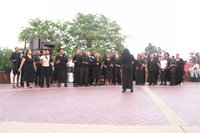Writers in repressive societies are considered dangerous.
That's why so many of them are in jail.
I decided to read my first Don Delillo work after I heard Curtis Sittenfeld, author of Prep and The Man of My Dreams (see May 23rd blog entry) mention "White Noise" as her top pick of novels from recent literary history. I believe the New York Times had just published a list of the top novels selected by a list of current authors. The top choice was Beloved by Toni Morrison, which Sittenfeld candidly admitted that she had never read. When she mentioned White Noise
The first person narrator, Jack Gladney, tells his story with relentless honesty. The world is too much with him, indeed. Technology's comforting white noise is always present. His children have jaded vulnerabilities that make you ache and cringe. His youngest child, Wilder, is too young to speak at all, yet brings the most comfort to the family (and the reader) by simply existing. His needs--food, water, sleep--give human life a simple purpose.
As I read through the increasingly bizarre events, which take place in an all-too-familiar traditional college town, I found myself admitting to my own fleeting (yet real) fixation on my own death and the death of my loved ones. Do you indulge in detailed visions of what-if cancer strikes? What-if the drunk driver hits my car? What-if it is my bag of spinach that carries my deadly calling number? Admit it.
The characters in White Noise often wander the supermarket and ponder its contents and displays for meaning. Delillo's choice to have them observe the supermarketplace was a clever choice as shiny tinfoil packages of snacks can tell an eloquent tale about the America of this era.
My father worked in the grocery industry and so I grew up knowing that there were stories behind how the bananas got to the produce section. I learned that bananas start off as vegetables and end up as fruit. I saw the climate-controlled rooms where bananas are held--frozen in time--until they are deemed ready to ripen for the stores. I used to think this destroyed the poetry behind the apples and oranges. Of course now I realize that seeing behind the display cases was seeing the poetry of the process. As mechanical and ugly as the process may be in comparison to the finished fruit.
Jack and his wife Babette go about their daily lives and deal with an airborne toxic event causing them to evacuate their town beneath a comforting blanket of white noise. Beneath the noise, however, is the ever present fear of death. A fear that drives them to confront or avoid their existence with a fierce determination to escape the fear, even if they can't escape death itself.
While I have not had a chance to discuss White Noise with fellow readers, I have read a few reviews and visited other useful sites:
by Jayne Anne Philips (originally appeared in the New York Times, January 13, 1985.)
New York Times Featured Author: Don DeLillo
This site contains reviews of DeLillo's books and an audio reading and interview.
The Don DeLillo Society
This site contains a bibliography, events, links, and more.
White Noise on White Noise
This site is a fun creation about White Noise.
I write to find out how much I know. The act of writing for me is a concentrated form of thought. If I don't enter that particular level of concentration, the chances are that certain ideas never reach any level of fruition.
DeLillo in an article by William Leith in 1991









